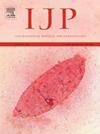澳大拉西亚 Ixodiphagus(膜翅目;Encyrtidae;Encyrtinae)的分子特征揭示了意想不到的多样性和潜在的新型宿主转换。
IF 3.7
2区 医学
Q1 PARASITOLOGY
引用次数: 0
摘要
蜱是重要的医学和兽医寄生虫,对人类、伴侣动物和牲畜的健康构成严重威胁。Ixodiphagus 黄蜂(膜翅目;Encyrtidae)是已知的蜱(硬蜱)和蜱(软蜱)的内寄生虫,具有天然生物控制剂的潜在用途。澳大利亚以前曾记录过两个物种,即 Ixodiphagus brunneus 和 Ixodiphagus mysorensis,但该属在澳大利亚缺乏正式的修订工作,这些物种的有效性和宿主范围仍不确定。这项研究旨在调查澳大拉西亚 Ixodiphagus 的多样性,并为今后研究这些研究不足的内寄生虫提供分子数据资源。我们从澳大利亚和新西兰昆虫馆藏的 Ixodiphagus 标本中提取了 DNA,并进行了高通量测序,从而获得了 11 个标本的完整或基本完整的线粒体基因组序列,其中包括 I. brunneus、Ixodiphagus taiaroaensis,以及从澳大利亚汤斯维尔的 Rhipicephalus linnaei 上饲养的新型 Ixodiphagus sp.。此外,我们还恢复了布鲁内斯虹鳟 Wolbachia 内共生体约 70% 的基因组。最后,我们利用 28S rRNA 和细胞色素 c 氧化酶亚单位 1(COI)基因 PCR 技术对最近从澳大利亚新南威尔士州南部采集的 178 份蜱样本进行了筛选,发现了 14 份阳性样本。基于 28S rRNA 和完整线粒体基因组序列的澳大拉西亚 Ixodiphagus spp.系统进化分析表明,澳大拉西亚动物群的成员与 Ixodiphagus hookeri(唯一有遗传数据的其他 Ixodiphagus 物种)不同,澳大利亚至少有两个不同的物种:I.从 Ixodes holocyclus 和 Haemaphysalis bancrofti 的蜱虫中发现了 Ixodiphagus brunneus,从昆士兰北部的 Rhipicephalus linnaei 的蜱虫中发现了一种未定性的 Ixodiphagus sp.。此外,在 I. brunneus 样本中,28S rRNA 位点存在大量遗传多样性,这可能代表正常的遗传变异或次生隐性物种。这里产生的分子数据是已知澳大拉西亚 Ixodiphagus 属的第一个数据,是世界动物群的两倍,并为这些重要的蜱寄生虫提供了第一个已知的完整线粒体基因组。本文章由计算机程序翻译,如有差异,请以英文原文为准。

Molecular characterisation of Australasian Ixodiphagus (Hymenoptera; Encyrtidae; Encyrtinae) reveals unexpected diversity and a potential novel host switch
Ticks are important medical and veterinary parasites that represent a substantial health threat to humans, companion animals, and livestock. Ixodiphagus wasps (Hymenoptera; Encyrtidae) are known endoparasitoids of ixodid (hard) and argasid (soft) ticks, with potential utility as natural biocontrol agents. Two species, Ixodiphagus brunneus and Ixodiphagus mysorensis, are previously recorded from Australia, however, the genus lacks formal revisionary work in Australia, and the validity and host ranges of these species remain uncertain. This work aimed to investigate the diversity of Ixodiphagus in Australasia and provide a molecular data resource for future work on these understudied endoparasitoids. We extracted DNA from archival Ixodiphagus specimens from Australian and New Zealand insect collections and performed high-throughput sequencing which resulted in complete or mostly complete mitochondrial genome sequences from 11 specimens, including I. brunneus, Ixodiphagus taiaroaensis, and a novel Ixodiphagus sp. reared from Rhipicephalus linnaei from Townsville, Australia. In addition, approximately 70% of the genome of the Wolbachia endosymbiont of I. brunneus was recovered. Finally, we screened 178 recently collected pooled tick samples from southern New South Wales, Australia, for Ixodiphagus spp. using 28S rRNA and cytochrome c oxidase subunit 1(COI) gene PCR, and recovered 14 positive samples. Phylogenetic analysis of Australasian Ixodiphagus spp. based on 28S rRNA and complete mitochondrial genome sequences determined that members of the Australasian fauna are distinct from Ixodiphagus hookeri (the only other Ixodiphagus species for which genetic data exists), and that at least two distinct species are present in Australia; I. brunneus identified from Ixodes holocyclus and Haemaphysalis bancrofti ticks, and an uncharacterised Ixodiphagus sp. found in Rhipicephalus linnaei ticks from northern Queensland. Furthermore, there was substantial genetic diversity at the 28S rRNA loci among I. brunneus samples, which may represent normal genetic variability or a secondary cryptic species. The molecular data generated here represents the first known for the genus Ixodiphagus in Australasia, doubling that of the world fauna, and provides the first known complete mitochondrial genomes for these important tick parasitoids.
求助全文
通过发布文献求助,成功后即可免费获取论文全文。
去求助
来源期刊
CiteScore
8.40
自引率
2.50%
发文量
76
审稿时长
23 days
期刊介绍:
International Journal for Parasitology offers authors the option to sponsor nonsubscriber access to their articles on Elsevier electronic publishing platforms. For more information please view our Sponsored Articles page. The International Journal for Parasitology publishes the results of original research in all aspects of basic and applied parasitology, including all the fields covered by its Specialist Editors, and ranging from parasites and host-parasite relationships of intrinsic biological interest to those of social and economic importance in human and veterinary medicine and agriculture.

 求助内容:
求助内容: 应助结果提醒方式:
应助结果提醒方式:


